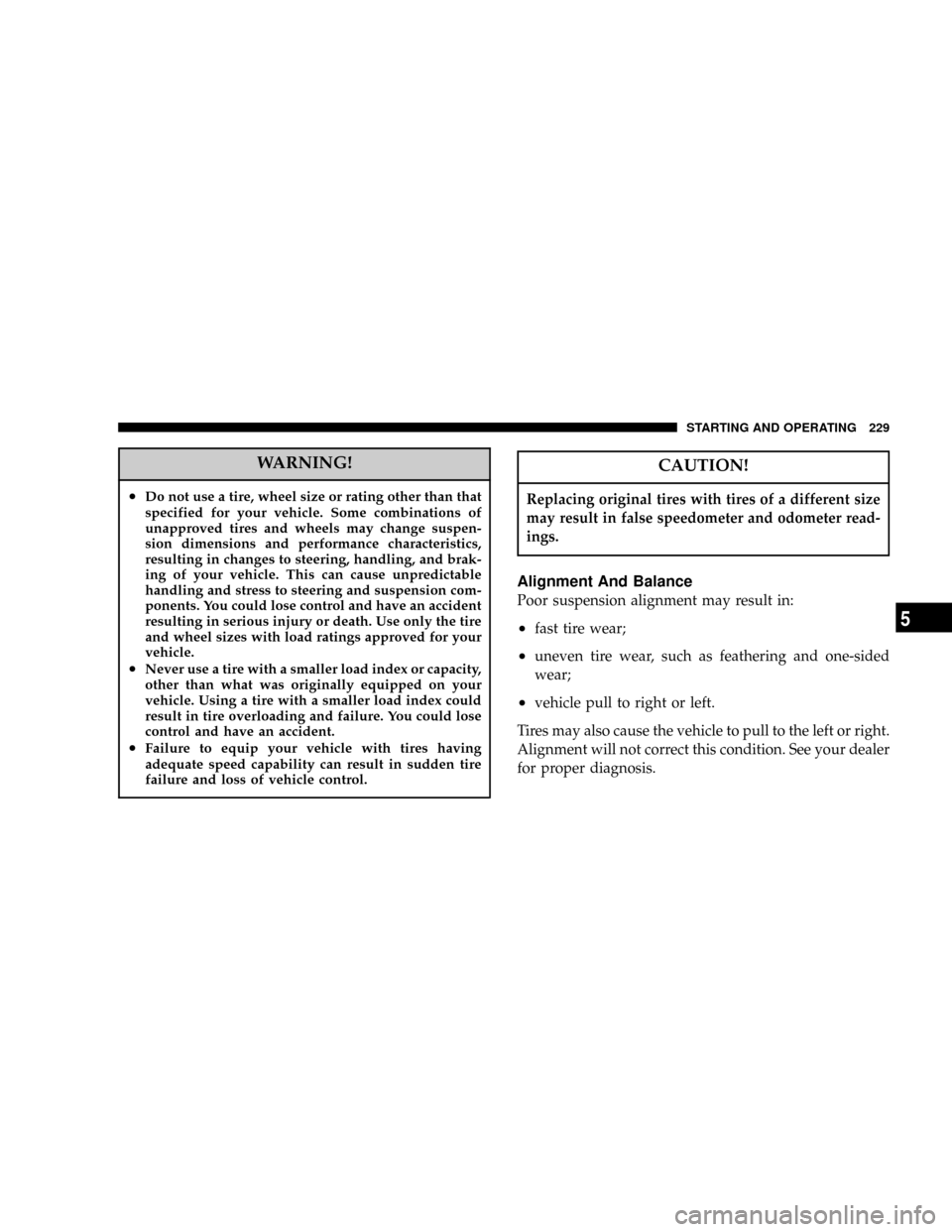2004 CHRYSLER PACIFICA tires
[x] Cancel search: tiresPage 229 of 361

WARNING!
²Do not use a tire, wheel size or rating other than that
specified for your vehicle. Some combinations of
unapproved tires and wheels may change suspen-
sion dimensions and performance characteristics,
resulting in changes to steering, handling, and brak-
ing of your vehicle. This can cause unpredictable
handling and stress to steering and suspension com-
ponents. You could lose control and have an accident
resulting in serious injury or death. Use only the tire
and wheel sizes with load ratings approved for your
vehicle.
²Never use a tire with a smaller load index or capacity,
other than what was originally equipped on your
vehicle. Using a tire with a smaller load index could
result in tire overloading and failure. You could lose
control and have an accident.
²Failure to equip your vehicle with tires having
adequate speed capability can result in sudden tire
failure and loss of vehicle control.
CAUTION!
Replacing original tires with tires of a different size
may result in false speedometer and odometer read-
ings.
Alignment And Balance
Poor suspension alignment may result in:
²fast tire wear;
²uneven tire wear, such as feathering and one-sided
wear;
²vehicle pull to right or left.
Tires may also cause the vehicle to pull to the left or right.
Alignment will not correct this condition. See your dealer
for proper diagnosis.
STARTING AND OPERATING 229
5
Page 230 of 361

Improper alignment will not cause vehicle vibration.
Vibration may be a result of tire and wheel out-of-
balance. Proper balancing will reduce vibration and
avoid tire cupping and spotty wear.
ALL WHEEL DRIVE (AWD) Ð IF EQUIPPED
CAUTION!
All Wheel Drive (AWD) vehicles must have the same
size and type tires on all wheel positions. Unequal
tire sizes must not be used. Unequal tire size may
cause failure of the power transfer unit and/or the
viscous coupling.
TIRE PRESSURE MONITOR SYSTEM Ð IF
EQUIPPED
The Tire Pressure Monitor System (TPM) system uses
wireless technology with wheel rim mounted electronic
sensors to monitor tire pressure levels (EXCLUDING
THE SPARE TIRE). Sensors, mounted to each wheel as
part of the valve stem, transmit tire pressure readings to
the Electronic Vehicle Information Center (EVIC) display
in the instrument cluster.
NOTE:It is particularly important, for you to check the
tire pressure in all of your tires regularly and too main-
tain the proper pressure.
When the appropriate conditions exist, the Electronic
Vehicle Information Center (EVIC) displays the following
messages.
230 STARTING AND OPERATING
Page 231 of 361
![CHRYSLER PACIFICA 2004 1.G Owners Manual 1,2,3, OR 4 TIRE(S) LOW PRESSURE
Low tire pressure levels of 25 psi [1.72 bars] (172 kPa) or
less detected in one or more tires.
Inspect all tires for proper inflation pressure, once the
proper tire p CHRYSLER PACIFICA 2004 1.G Owners Manual 1,2,3, OR 4 TIRE(S) LOW PRESSURE
Low tire pressure levels of 25 psi [1.72 bars] (172 kPa) or
less detected in one or more tires.
Inspect all tires for proper inflation pressure, once the
proper tire p](/manual-img/25/8497/w960_8497-230.png)
1,2,3, OR 4 TIRE(S) LOW PRESSURE
Low tire pressure levels of 25 psi [1.72 bars] (172 kPa) or
less detected in one or more tires.
Inspect all tires for proper inflation pressure, once the
proper tire pressure has been set, the TPM system
warning will reset automatically when the vehicle has
been driven for at least 2 minutes at or above 20 mph (32
km/h).
1,2,3, OR 4 TIRE(S) HIGH PRESSURE
High tire pressure levels of 45 psi [3.10 bars] (310 kPa) or
more detected in one or more tires.
Inspect all tires for proper inflation pressure, once the
proper tire pressure has been set, the TPM system
warning will reset automatically when the vehicle has
been driven for at least 2 minutes at or above 20 mph (32
km/h).
SERVICE TIRE PRESSURE SYSTEM/SEE
OWNER'S MANUAL
The Tire Pressure Monitor System (TPM) system requires
service.
See your authorized dealer for service.
TIRE PRESSURE UNAVAILABLE
The TPM system function is temporarily unavailable due
to external electromagnetic interference, such as portable
electronic devices, or near by radio or TV towers.
Move the vehicle to an area free from radio, TV antennas
and transmitting towers or disconnect any portable elec-
tronic devices. Once the external interference is removed
the TPM system will resume normal operation and ªTIRE
PRESSURE NOW AVAILABLEº will appear in the Elec-
tronic Vehicle Information Center (EVIC) display.
STARTING AND OPERATING 231
5
Page 232 of 361

CAUTION!
The TPM system has been optimized for the original
equipment tires and wheels. TPM system pressures
have been established for the tire size equipped on
your vehicle. Undesirable system operation or sen-
sor damage may result when using replacement
equipment that is not of the same size, type, and/or
style. After-market wheels can cause sensor damage.
Do not use tire sealant or balance beads if your
vehicle is equipped with a TPM system, as damage
to the sensors may result.
NOTE:
²The TPM system can inform the driver of a low tire
pressure condition of 25 psi [1.72 bars] (172 kPa) or
less, or high a tire pressure condition of 45 psi [3.10
bars] (310 kPa) or more.
²The TPM system is not intended to replace normal tire
care and maintenance, nor to provide warning of a tire
failure or condition.
²The TPM system should not be used as a tire pressure
gauge while adjusting your tire pressure.
²The TPM system must be retrained after a tire rotation
or wheel rim mounted sensor replacement. See your
authorized dealer for service.
CAUTION!
After inspecting or adjusting the tire pressure al-
ways reinstall the valve stem cap, if equipped. This
will prevent moisture and dirt from entering the
valve stem, which could damage the wheel rim
sensor.
232 STARTING AND OPERATING
Page 233 of 361

General Information
This device complies with part 15 of the FCC rules and
RSS 210 of Industry Canada. Operation is subject to the
following conditions:
²This device may not cause harmful interference.
²This device must accept any interference received,
including interference that may cause undesired op-
eration.
The tire pressure sensors are covered under one of the
following licenses:
United States.....................KR5S120123
Canada........................2671-S120123
TIRE CHAINS
Use only compact chains, or other traction aids that meet
SAE type ªClass Sº specifications. Chains must be the
proper size for the vehicle, as recommended by the chain
manufacturer.
NOTE:Do not use tire chains on a compact spare tire.
CAUTION!
To avoid damage to your vehicle or tires, observe the following
precautions:
²Because of restricted chain clearance between tires and
other suspension components, it is important that only
chains in good condition are used. Broken chains can cause
serious damage. Stop the vehicle immediately if noise
occurs that could indicate chain breakage. Remove the
damaged parts of the chain before further use.
²Install chains on the front wheels as tightly as possible and
then retighten after driving about1¤2mile (0.8 km).
²Do not exceed 45 mph (70 km/h).
²Drive cautiously and avoid severe turns and large bumps,
especially with a loaded vehicle.
²Do not use on rear wheels of All Wheel Drive (AWD)
vehicles.
²Do not drive for prolonged period on dry pavement.
²Observe the tire chain manufacturer's instructions on the
method of installation, operating speed, and conditions for
use. Always use the lower suggested operating speed of the
chain manufacturer if different than the speed recom-
mended by the manufacture.
STARTING AND OPERATING 233
5
Page 234 of 361

NOTE:In order to avoid damage to tires, chains, and
your vehicle do not drive for a prolonged period of time
on dry pavement. Observe the tire chain manufacturer's
instructions on method of installation, operating speed,
and conditions for usage.
Always use the lower suggested operating speed if both
the chain manufacturer and vehicle manufacture suggest
a maximum speed. This notice applies to all chain
traction devices, including link and cable (radial) chains.
SNOW TIRES
Some areas of the country require the use of snow tires
during winter. Standard tires are of the all season type
and satisfy this requirement as indicated by the M+S
designation on the tire side wall.
If you need snow tires, select tires equivalent in size and
type to the original equipment tires. Use snow tires only
in sets of 4, failure to do so may adversely affect the
safety and handling of your vehicle.Snow tires generally have lower speed ratings than what
was originally equipped with your vehicle and should
not be operated at sustained speeds over 75 mph (120
km/h).
TIRE ROTATION RECOMMENDATIONS
Tires on the front and rear axles of vehicles operate at
different loads and perform different steering, driving,
and braking functions. For these reasons, they wear at
unequal rates, and tend to develop irregular wear pat-
terns.
These effects can be reduced by timely rotation of tires.
The benefits of rotation are especially worthwhile with
aggressive tread designs such as those on all season type
tires. Rotation will increase tread life, help to maintain
mud, snow, and wet traction levels, and contribute to a
smooth, quiet ride.
Follow the recommended tire rotation frequency for your
type of driving found in the ªMaintenance Schedulesº
234 STARTING AND OPERATING
Page 242 of 361

²Vehicle Identification Number (VIN)
²Type of Vehicle
²Month Day and Hour of Manufacture (MDH)
The bar code allows a computer scanner to read the
Vehicle Identification Number (VIN).
Gross Vehicle Weight Rating (GVWR)
The GVWR is the total allowable weight of your vehicle.
This includes driver, passengers, and cargo. The total
load must be limited so that you do not exceed the
GVWR.
Gross Axle Weight Rating (GAWR)
The GAWR is the maximum capacity of the front and rear
axles. Distribute the load over the front and rear axles
evenly. Make sure that you do not exceed either front or
rear GAWR.
WARNING!
Because the front wheels drive and steer the vehicle,
it is important that you do not exceed the maximum
front or rear GAWR. A dangerous driving condition
can result if either rating is exceeded. You could lose
control of the vehicle and have an accident.
Overloading
The load carrying components (axle, springs, tires,
wheels, etc.) of your vehicle will provide satisfactory
service as long as you do not exceed the GVWR and front
and rear GAWR.
The best way to figure out the total weight of your
vehicle is to weigh it when it is fully loaded and ready for
operation. Weigh it on a commercial scale to insure that it
is not over the GVWR.
242 STARTING AND OPERATING
Page 252 of 361

WARNING!
A hot engine cooling system is dangerous. You or
others could be badly burned by steam or boiling
coolant. You may want to call a service center if your
vehicle overheats. If you decide to look under the
hood yourself, see Section 7, Maintenance, of this
manual. Follow the warnings under the Cooling
System Pressure Cap paragraph.
JACKING AND TIRE CHANGING
WARNING!
²Getting under a jacked-up vehicle is dangerous.
The vehicle could slip off the jack and fall on you.
You could be crushed. Never get any part of your
body under a vehicle that is on a jack. If you need
to get under a raised vehicle, take it to a service
center where it can be raised on a lift.
²The jack is designed to use as a tool for changing
tires only. The jack should not be used to lift the
vehicle for service purposes. The vehicle should
be jacked on a firm level surface only. Avoid ice or
slippery areas.
252 WHAT TO DO IN EMERGENCIES